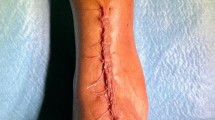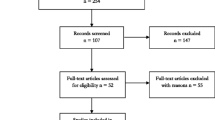Abstract
Introduction
Closed suction drainage is an established procedure in arthroscopic surgery. It is intended to reduce the retention of wound and irrigation fluids, which form the basis for postoperative swelling, pain, and infection. However, currently, there is no scientific review of the actual benefit of this procedure.
Methods
Between 2020 and 2021, 84 patients (53 males, 31 females; mean age: 42 years) were prospectively randomised into this study. The patients underwent arthroscopic surgery of the ankle joint with (group A) or without (group B) insertion of a closed suction drain (42 patients per group). Assessments included upper ankle swelling using the figure-of-eight-20 method, pain preoperatively and 48 h postoperatively, and unexpected events within 6 weeks postoperatively.
Results
The measurements performed 48 h postoperatively showed a mean circumferential increase of 1.38 cm (1.48 and 1.28 cm in groups A and B, respectively; p > 0.05) in all patients. The mean pain at rest, assessed using the visual analogue scale (maximum 10 points), was 2.7 and 2.4 in groups A and B, respectively (p > 0.05). Overall, two minor complications occurred: residual swelling in group A and persistent limitation of movement in group B. The average length of hospital stay was 2.4 days (p > 0.05).
Conclusions
Based on the available data, the routine insertion of a closed suction drainage at the upper ankle does not offer any objective benefit and must be considered obsolete. From both a medical and an economic point of view, the decision to conduct this procedure should be justified on an individual basis.
Level of evidence
Level I, prospective randomised trial.




Similar content being viewed by others
Availability of data and material
All data intended for publication are included in the manuscript.
References
Bao T, Han F, Xu F, Yang Y, Shu X, Chen K et al (2017) Papineau technique combined with vacuum-assisted closure for open tibial fractures: clinical outcomes at five years. Int Orthop 41:2389–2396
Devoogdt N, Cavaggion C, Van der Gucht E, Dams L, De Groef A, Meeus M et al (2019) Reliability, validity, and feasibility of water displacement method, figure-of-eight method, and circumference measurements in determination of ankle and foot edema. Lymphat Res Biol 17:531–536
Erne F, Wetzel S, Wulker N, Gesicki M, Hofmann UK (2018) Closed suction drainage after primary total knee arthroplasty: a prospective randomized trial. J Knee Surg 31:804–810
Ewald TJ, Holte P, Cass JR, Cross WW 3rd, Sems SA (2015) Does ankle aspiration for acute ankle fractures result in pain relief? A prospective randomized double-blinded placebo controlled trial. J Orthop Trauma 29:399–403
Fichman SG, Makinen TJ, Lozano B, Rahman WA, Safir O, Gross AE et al (2016) Closed suction drainage has no benefits in revision total hip arthroplasty: a randomized controlled trial. Int Orthop 40:453–457
Friends J, Augustine E, Danoff J (2008) A comparison of different assessment techniques for measuring foot and ankle volume in healthy adults. J Am Pediatr Med Assoc 98:85–94
Henschke N, Boland RA, Adams RD (2006) Responsiveness of two methods for measuring foot and ankle volume. Foot Ankle Int 27:826–832
Migliorini F, Maffulli N, Betsch M, Eschweiler J, Tingart M, Baroncini A (2021) Closed suction drainages in lower limb joint arthroplasty: a level I evidence based meta-analysis. Surgeon. https://doi.org/10.1016/j.surge.2021.02.014
Muoghalu ON, Eyichukwu GO, Iyidobi E, Anyaehie UE, Madu KA, Okwesili IC (2019) A comparison of the use and non-use of closed suction wound drainage in open reduction and internal fixation of femoral shaft fractures. Int Orthop 43:2003–2008
Parker MJ, Livingstone V, Clifton R, McKee A (2007) Closed suction surgical wound drainage after orthopaedic surgery. Cochrane Database Syst Rev (3):CD001825
Parker MJ, Roberts C (2001) Closed suction surgical wound drainage after orthopaedic surgery. Cochrane Database Syst Rev (4):CD001825
Quinn M, Bowe A, Galvin R, Dawson P, O’Byrne J (2015) The use of postoperative suction drainage in total knee arthroplasty: a systematic review. Int Orthop 39:653–658
Rohner-Spengler M, Mannion AF, Babst R (2007) Reliability and minimal detectable change for the figure-of-eight-20 method of, measurement of ankle edema. J Orthop Sports Phys Ther 37:199–205
Song YH, Li S, Lin DM, Lin XY, Zhou FY, Chen YH et al (2016) Clinical research of vacuum sealing drainage combined with artificial dermis for the treatment of ankle and foot soft tissue defects. Zhongguo Gu Shang 29:761–763
Tiwari V, Dwidmuthe S, Sahoo SS (2020) Letter to the Editor: The “cough trick” reduces pain during removal of closed-suction drains after total knee arthroplasty: a randomized trial. Clin Orthop Relat Res 478:1133–1134
Tsang LF, Cheng HC, Ho HS, Hsu YC, Chow CM, Law HW et al (2016) Translating evidence-based protocol of wound drain management for total joint arthroplasty into practice: a quasi-experimental study. Int J Orthop Trauma Nurs 21:49–61
Walsh TP, Butterworth PA, Urquhart DM, Cicuttini FM, Landorf KB, Wluka AE et al (2017) Increase in body weight over a two-year period is associated with an increase in midfoot pressure and foot pain. J Foot Ankle Res 10:31
Wang D, Xu J, Zeng WN, Zhou K, Xie TH, Chen Z et al (2016) Closed suction drainage is not associated with faster recovery after total knee arthroplasty: a prospective randomized controlled study of 80 patients. Orthop Surg 8:226–233
Xu C, Jia CQ, Kuo FC, Chai W, Zhang MH, Chen JY (2019) Does the use of a closed-suction drain reduce the effectiveness of an antibiotic-loaded spacer in two-stage exchange arthroplasty for periprosthetic hip infection? A prospective, randomized, controlled study. BMC Musculoskelet Disord 20:583
Zhou XD, Li J, Xiong Y, Jiang LF, Li WJ, Wu LD (2013) Do we really need closed-suction drainage in total hip arthroplasty? A meta-analysis. Int Orthop 37:2109–2118
Funding
No funding was received.
Author information
Authors and Affiliations
Corresponding author
Ethics declarations
Conflict of interest
All authors declare that they have no conflict of interest. All authors agree to the publication of the data.
Ethical statement
All procedures were performed in accordance with the 1964 Helsinki Declaration and its later amendments or comparable ethics standards.
Ethical approval
The ethics committee of the institutional review board approved this study (2020-1973-evBO).
Informed consent
All patients were informed in detail about study participation and publication of data. Written informed consent was required prior to participation in this study.
Additional information
Publisher's Note
Springer Nature remains neutral with regard to jurisdictional claims in published maps and institutional affiliations.
Rights and permissions
About this article
Cite this article
Fischer, S., Heusgen, C., Brkic, M. et al. Value of closed suction drainage in arthroscopic and minimally invasive surgery of the ankle joint: a prospective randomised study. Arch Orthop Trauma Surg 143, 657–663 (2023). https://doi.org/10.1007/s00402-021-04107-4
Received:
Accepted:
Published:
Issue Date:
DOI: https://doi.org/10.1007/s00402-021-04107-4




